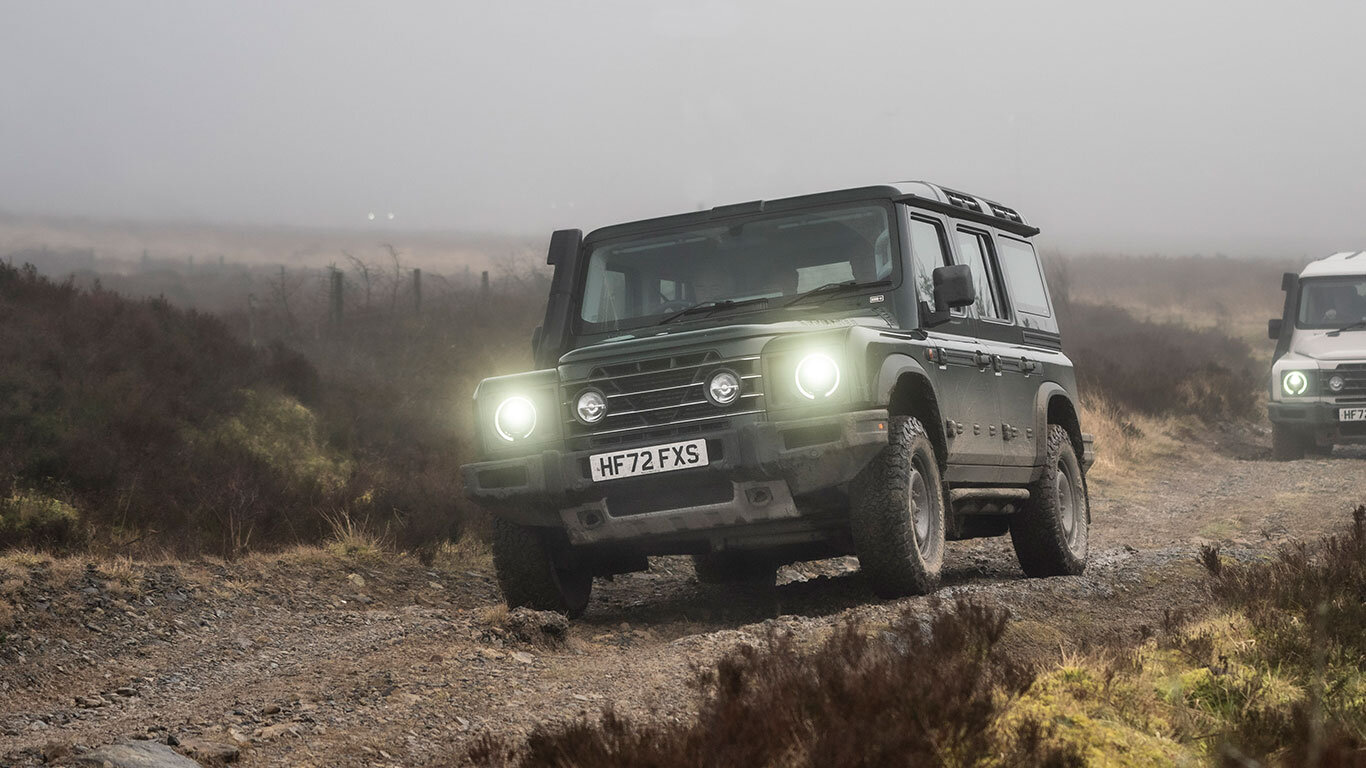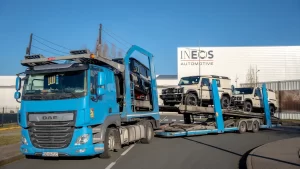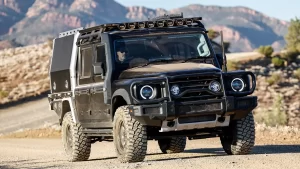“Welcome aboard the new INEOS Grenadier on this inaugural EXPEDITION 1.0 from Roxburghe Estate, Scotland, to Cartmel Village, England. Our journey begins with a drive through breathtaking landscapes surrounding the fabled Lawless Marches and Debatable Lands with pine forests and the peat bogs of Kielder Forest. After crossing the border into England we continue through the Lake District before embarking on the final leg which will take us to the historic ford through Morecambe Bay. Fasten your seat belt and adjust the seat to an upright sitting position. Enjoy the ride.”
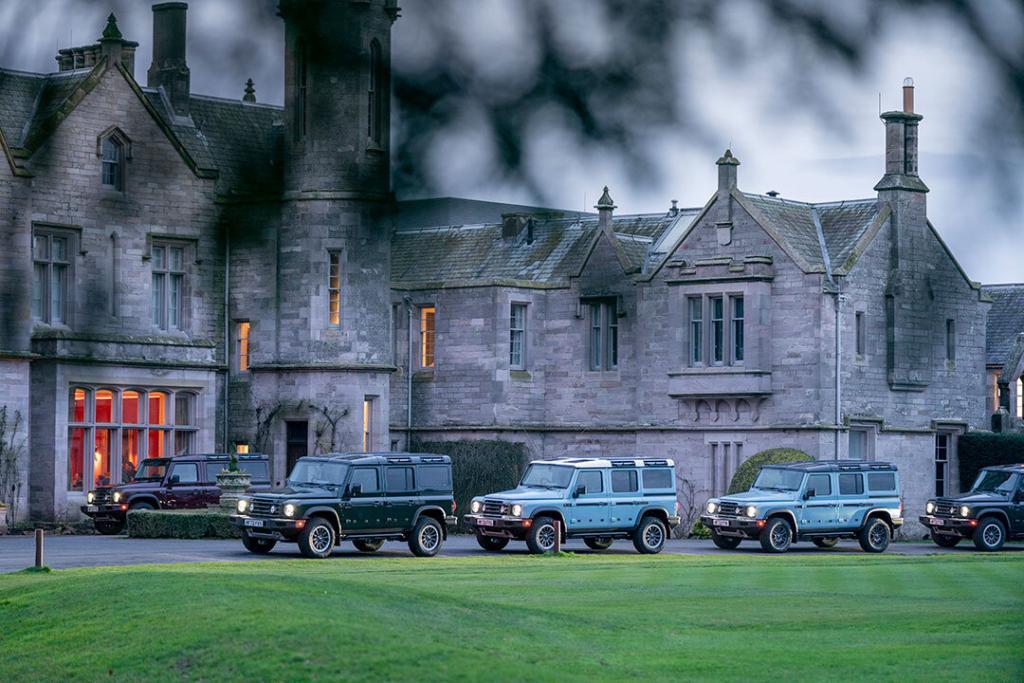
This must surely be the best way to experience the quality and performance that defines the INEOS Grenadier. I’d been feverishly awaiting my chance to put the Grenadier through its paces in its natural habitat for days. Up until now, I’d only seen prototypes fitted with an interior out of a 3D printer which merely hinted at how it might eventually look. Now I’m standing in front of the real thing: pristine as if it had just rolled off the production line in Hambach; splendid in its Magic Mushroom livery.

The bodywork’s silhouette is indicative of the car’s functionality. Well-defined contours, excellent all-round visibility, generous approach, departure and ramp angles, plenty of ground clearance, good wading ability, fixing rails along the flanks, and doors that open wide. There is no doubt about it: “get ready for off-road.” Spoiler alert: the Grenadier is no slouch on-road either.
Opening the driver’s door—which is on the right, for a change—I make myself comfortable in the driving seat. Or, more accurately, in the RECARO pilot’s seat. This cockpit is unlike anything I’ve seen before. The seat fits like a glove, or a well-fitting Belstaff jacket; the side bolsters provide excellent lateral support.
On my left, in the central console, are the shifter for the 8-speed ZF gearbox, the dial to operate the 12.3” navigation and infotainment touchscreen, and the selectors for the central diff lock and low range on the transfer case.
The controls situated in the centre of the dashboard take care of the air conditioning, heated seats, windscreen heaters, and park assist.
But there are still more to come: switches in the roof panel are designated for off-pavement driving and deploy the front and rear diff locks, off-road and wade modi, downhill and uphill assist, and other optional features which make use of the external power points in the roof.

Once the familiar B58 286 BHP BMW 3-litre straight six is fired up, I ease the Grenadier onto the road. I have to admit, the vehicle is not my main priority at this point and it takes a couple of miles, junctions and roundabouts before I’ve acclimatised myself to driving on the left. Despite the car’s 2.7 tons, the powerful petrol engine with its 450 Nm is more than enough to speed me smoothly through the typically twisty British country lanes. If you need more torque, then you can choose the six-cylinder BMW B57 diesel with 550 Nm which makes light work of towing a 3.5 ton trailer.
The steering wheel is ergonomically formed and enhances the feeling of having control in any driving situation. I did have to get used to the steering though: it isn’t as direct as you might expect from a modern car, but still precise.
You can’t overlook the small red button on one spoke of the steering wheel. No, it doesn’t turn on the boost, it’s what they call the toot hoot, a pleasant and discreet horn designed not to scare the wits out of cyclists or pedestrians, but to gently announce one’s presence to them.
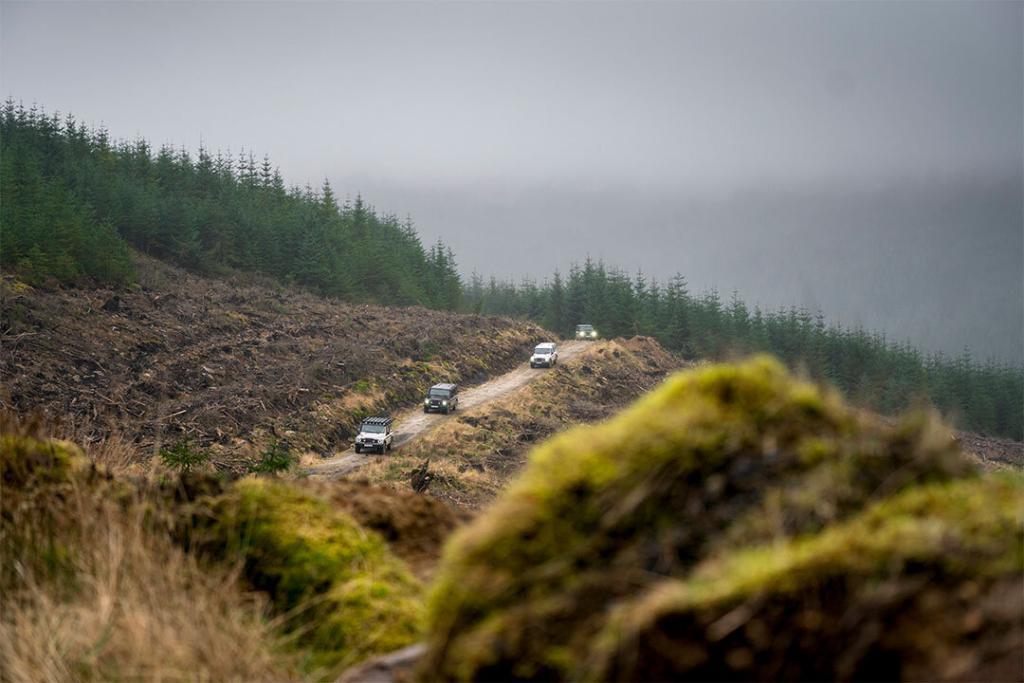
After a good stretch of road we turned left through the gates leading to the majestic Floors Castle, the largest inhabited castle in Scotland, and our first venture off-road: the vast expanse of peat bogs in Kielder Forest. The factory-fitted BG Goodrich K02 cope well with the boggy, loamy and muddy passages but I did engage the central diff lock for a solid 50:50 power distribution to the front and rear axles.
I followed a long service track through the moor until I reached a pine forest with a steep serpentine ascent. Just to be on the safe side, I used the switch in the roof panel to activate the rear diff lock. With the 2.5:1 gear reduction also engaged, the Grenadier is even easier to steer accurately through the tight bends whilst delivering just the right amount of amount of power to the wheels.
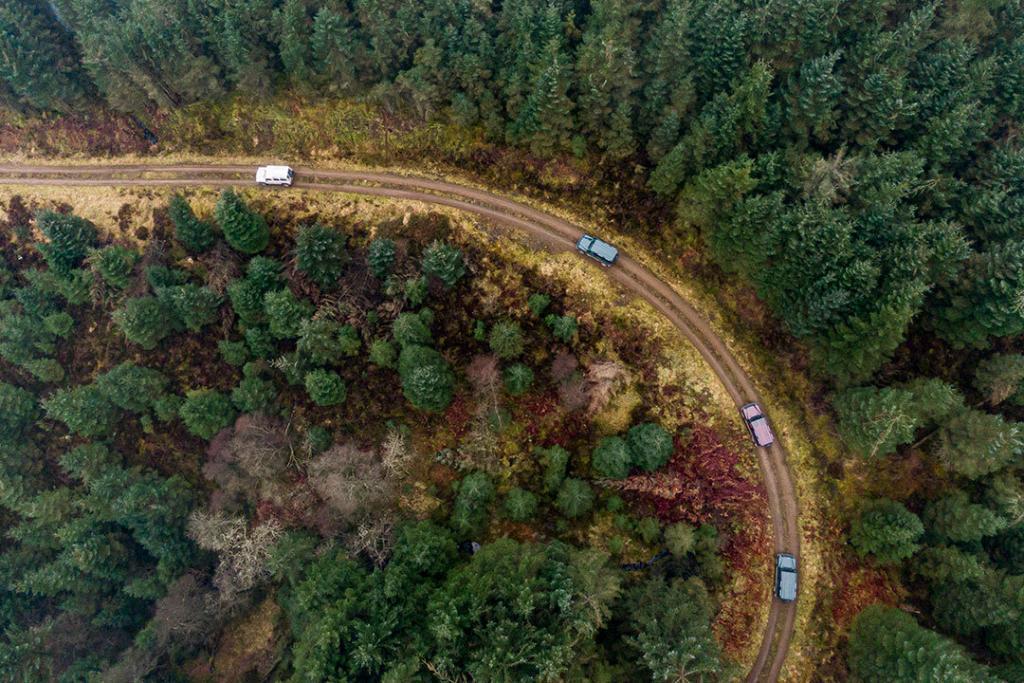
A little later, I was confronted by a gentle, but extremely slippery, grass slope. An ideal opportunity to test the Downhill Assistant. A typical off-pavement scenario encountered on campsites or on a farm. I left the car to do all the braking and was rewarded with a perfectly straight descent.
With the first day wrapped up, the Grenadier has gained its first patina and I have to say it looks pretty good. Fortunately, there are drain plugs in the driver’s and passenger footwells allowing them to be rinsed out with a hose. A further characteristic that underlines this car’s designation for real off-road use.
Then, we were back on the road, more accurately twisty and narrow country lanes, leading through the hills to the English border. We left Scotland on tracks that cut their way through Kielder Forest (England’s largest man-made woodland and, for many years, where WRC rallies and the British Rally Championship were held), to Ullswater, the second largest body of water in the Lake District and perfect for some driving thrills.
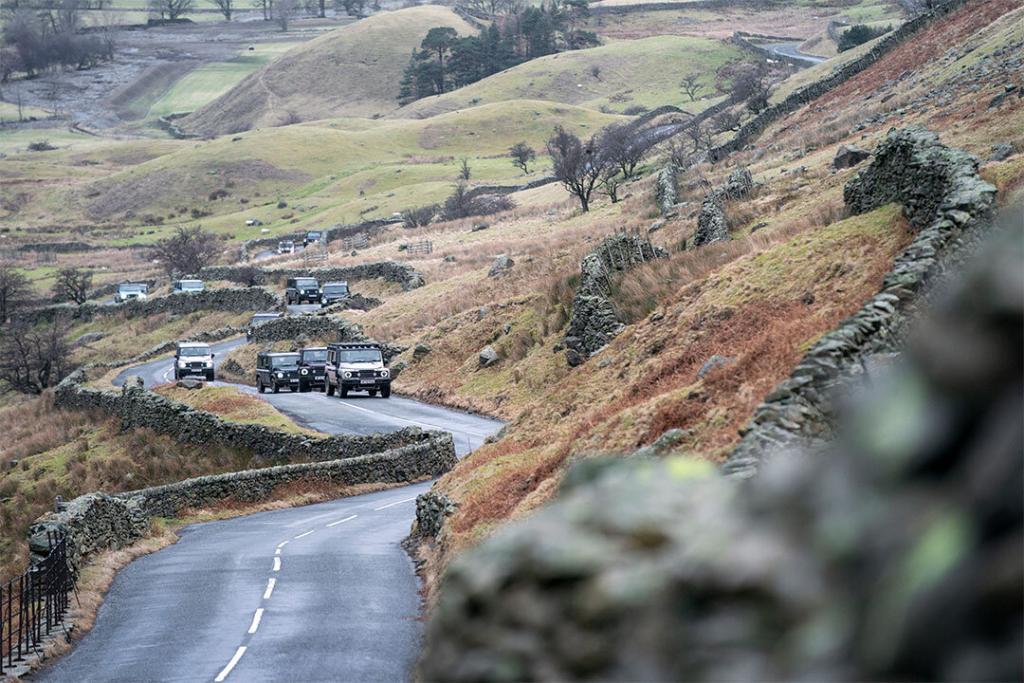
The first thing I needed to do at the end of the day, was gather my thoughts and sift through all the information I had collected. It was only five years ago when the very first impression of an INEOS Grenadier was sketched onto a banknote. Now it stands before me and not just a 3D-printed model, but a production car. In my opinion, all of the expectations in regard to function and equipment have been met to an extraordinary level.
Even so, there were a few details that might be worth paying attention to a little further down the line: operating the switches and buttons in the roof panel certainly takes some getting used to, because not everyone is a pilot, but they are well organised. Unfortunately, I’m not only short-sighted, but also a little long-sighted which means I have to wear glasses. This proved to be a disadvantage when I first got into the car and tried to find a particular switch—I simply couldn’t read the labelling. However, after a full day of intensive driving and testing, you quickly learn where each control is situated and can engage them almost intuitively. Even so, the LED lamp still remains covered by your finger so that you have to shift slightly to see whether or not the accessory has been activated or not. All a matter of practice.
I switched cars on day two so that I could test the alternative engine: the straight six BMW diesel. Amongst others, we’re going to drive through the slate quarries in Burlington today.
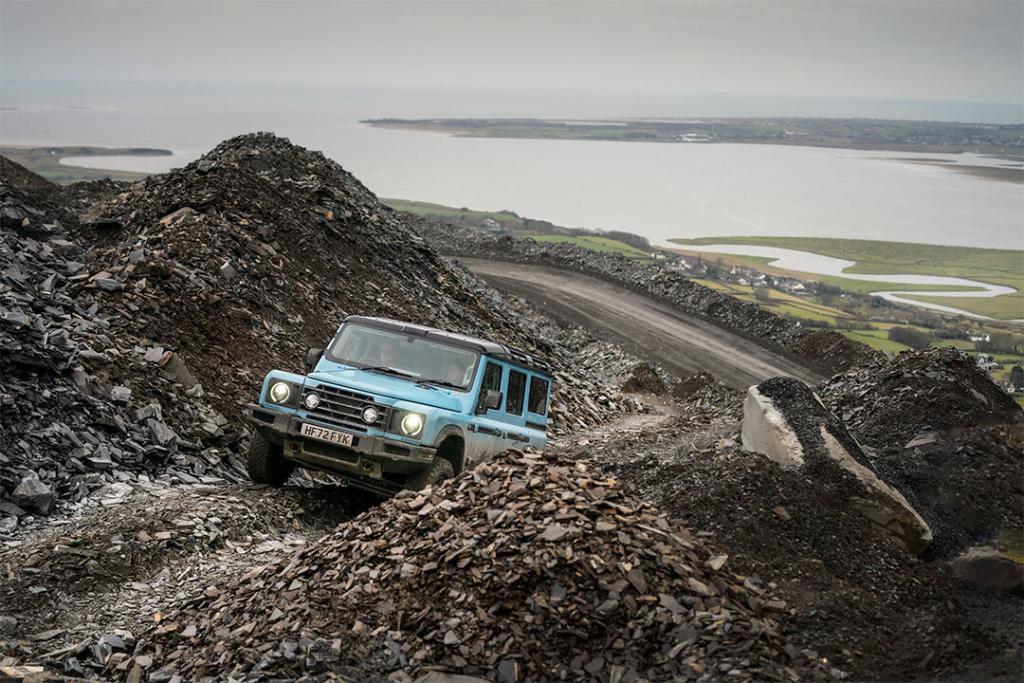
The ignition key is inserted into the lock on the left of the steering wheel. This isn’t the most ideal position because there is only around ten centimetres of space between it and my knee. I couldn’t shrug off the feeling that if I were to be involved in an accident, my knee would almost certainly hit it. The ignition switch and key could have been integrated into the central dashboard instead.
Nevertheless, I was still all smiles from the previous day when we kicked off with another lengthy stretch of asphalt. The road winds its way up and around Ullswater, over Kirkstone Pass, across Wrynose Pass and on to Hardknott Pass, aptly known as the wildest roads in England. Perfect for the Grenadier and, with gradients of up to 33%, potentially challenging. But the car took it all in its stride.
We neared another highlight: Burlington’s grinding stone quarry. We wound our way between loaders and dump trucks to the test area which was riddled with boulders. Off-road mode and low rations engaged and, as a warm-up, we drive across steep slopes and through deep impressions: now the Grenadier has got to prove how well it can articulate. With almost 60 cm of travel, we’ve got quite a lot to work with. The car lifts one wheel after another, but not once was the forward momentum interrupted. The steering wheel feels good and exudes confidence. I can sense how the car pulls its way through the obstacles completely undeterred.
I turned left at the next opportunity and followed the track down to a roughly 100-metre-long test section filled completely with glutinous mud. As I had no intention of getting stuck, I engaged the rear diff lock which splits the power 50/50 to each of the rear wheels. I built up some speed and let the factory-fitted BF Goodrich K02 tyres dig their way through. Mud flew everywhere and the paint was given a wonderful coat of grey mud. Now the Grenadier looks like a real off-roader. I switched off the diff lock again.
Next up was a speed test along a service track. This is where I really got to know the suspension—all four wheels were planted firmly on the ground at all times, and I felt very confident and safe. I never got the feeling the Grenadier was nearing its limits. After a 90° bend, we were heading skyward at 45°. And just to make things more interesting the ascent had another section to test the axle articulation. This time I engaged both front and rear diff locks. Gently depressing the accelerator, the 2.7-ton off-roader crept its way up to the plateau. I tell you, I could spend all day playing around here.
After cleaning the windows and lights, in keeping with the highway code, we drove to our next and, sadly, final destination. The time and tide were in our favour so that we could grasp the unique opportunity to drive the Grenadier through Morecambe Bay. The trail across the flats is approximately seven miles long. If you want to stop, do it on firmer ground. Otherwise, the car is more than likely to sink into the “liquid” sands. No thank you…I’ve had my fair share of bogged down vehicles and I wasn’t looking for any repetitions.
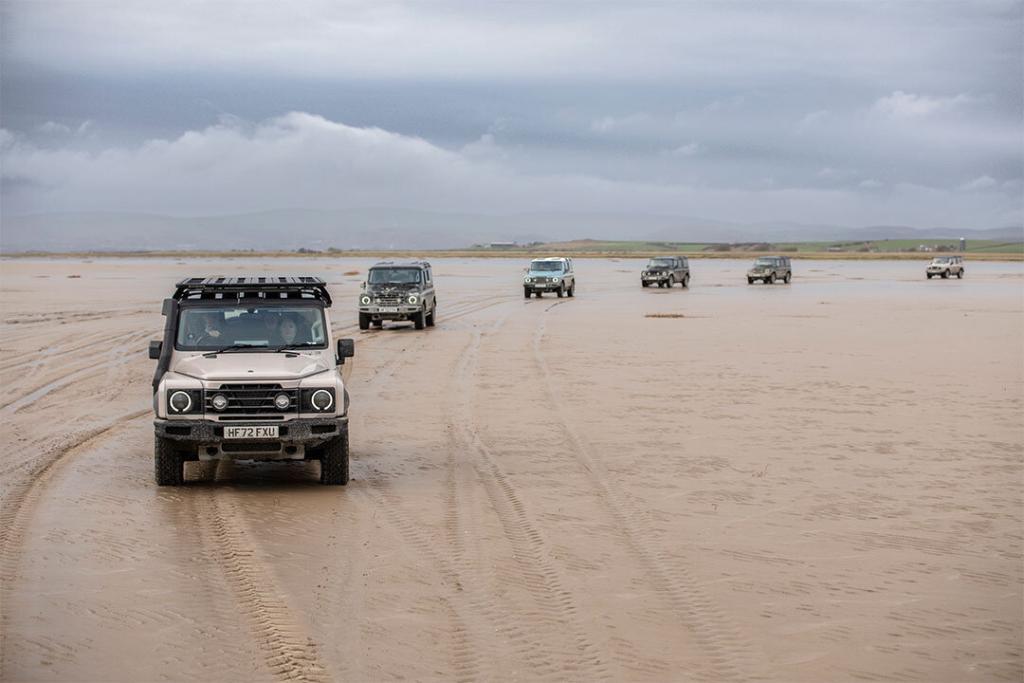
Driving over sandbanks and small tideways is really exhilarating. To pump things up even more, we drove through two river spurs before reaching the other side of the bay. Just to make sure nothing untoward happened on this seven-mile stage, we were accompanied by the King’s Guide to the Sands, who knows the area like the back of his hand.
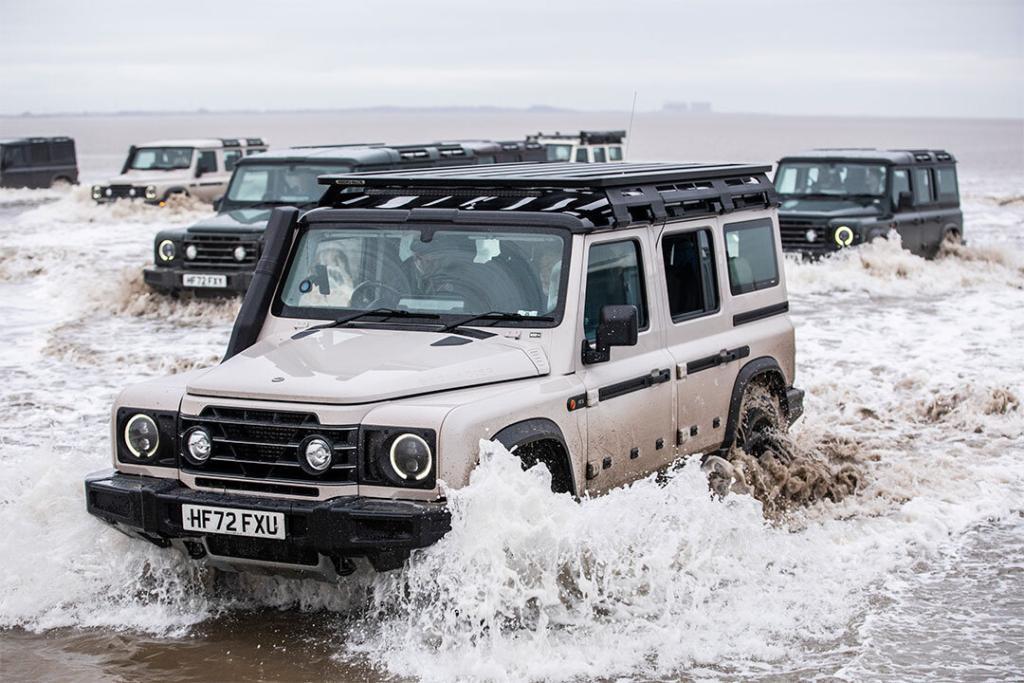
The day drew to a close, as did my chance to test this fantastic vehicle. These two days gave the Grenadier the opportunity to really show how well it performs on pavement and in rugged terrain.
SUMMING UP
It’s hard to overlook its functionality. There simply aren’t any unnecessary features. Currently, you won’t even find a blind-spot assistant, distance warning or a 360° camera view in the price list. I think it’s safe to say they will be included in the next update, but I can’t say I missed them.
Elegantly accessorised in the Belstaff Fieldmaster and Trialmaster guises, or Rough as Grenadier, there is a model to satisfy most needs. Personally, I strongly recommend ordering the optional electric package, including the additional battery under the rear seat, and the front and rear diff locks. You can’t lay cables to the roof so inconspicuously, and the two additional diff locks mean you will cope with just about any kind of terrain you come across.
And then there’s the winch for the most extreme situations. It is well integrated into the front bumper and is one of the Grenadier’s unique features. With a maximum payload of 5.5 tons, it has plenty of reserves for the toughest off-road challenges.
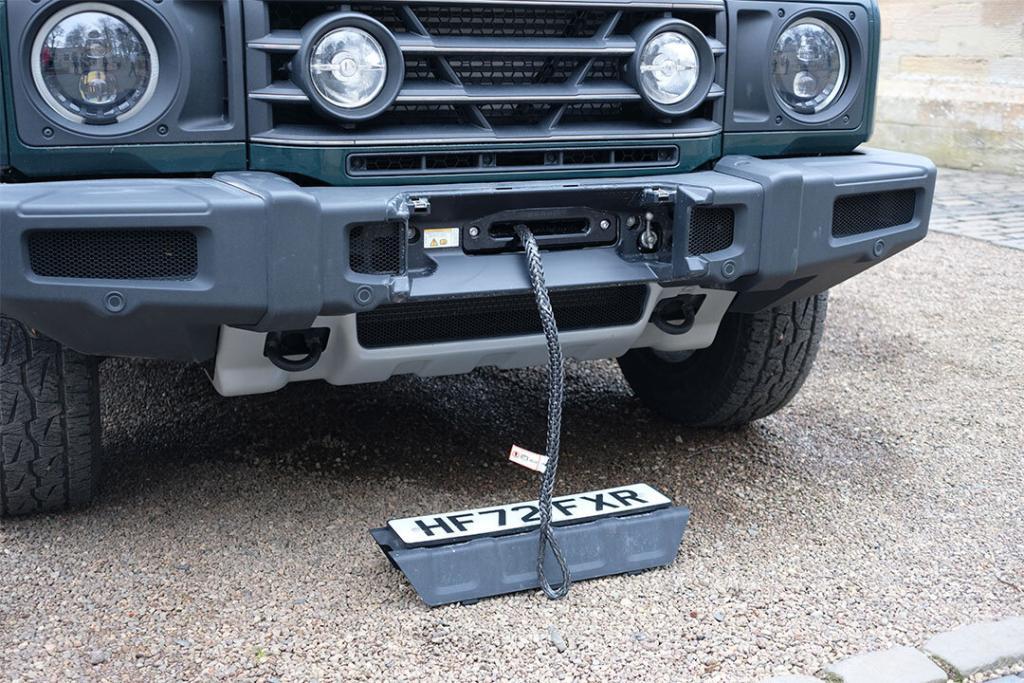
After a short while to acclimatise, you quickly get used to the unusual combination of dashboard and control panels so that you quickly find the switch you need. The designers refrained from including automatic off-road driving programmes, which means the driver has to read the terrain and select the gear ratios and diff locks accordingly. This way his concentration levels will be higher and, in my opinion, give him an improved chance of averting, or getting out of, difficult situations.
To help the driver keep both hands on the wheel, I would like to see two paddles on the steering wheel so that I can manually select the gears. Currently, you can only use the selector on the gearbox itself.
Either available as factor-fitted or optional accessories, there are plenty of options to configure the vehicle for specific uses—such as the fixing rails along the flanks, retaining points and power sockets on the roof, and the large 30/70 rear doors. Whether additional lighting, roof rack, or even loading a Euro pallet, the possibilities for leisure or commercial use are almost limitless. Depending on how the car is accessorised and the choice of power train, you have a payload of up to 871 kg and the cargo space will swallow up to 2,088 litres with the rear seats folded down.

Those were two challenging and interesting days to test the production Grenadier in beautiful Lake District surroundings. INEOS hasn’t just succeeded in consistently realising the features listed in the catalog of requirements drawn up during the planning phase, but also included several INEOS family features: from the Belstaff jacket model names, the green and red stripes in the centre console (for starboard and port from sailing), the toot horn as a tribute to cycling, and the individual stories behind the names for each exterior colour—the Grenadier is a vehicle that was tangibly born out of passion.
Given the chance, I would have driven home in the Grenadier. It’ll take me days to wipe the smile off my face.
Take a seat, experience the Grenadier, and enjoy a different way to drive off road.

